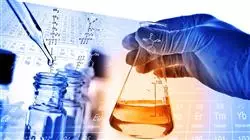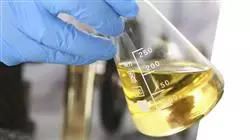University certificate
Accreditation/Membership

The world's largest faculty of engineering”
Introduction to the Program
This PProfessional master’s degree will lead you to specialize in Chemical Engineering oriented to sustainability and innovation in this sector"

The increased awareness of environmental protection has led chemical industry professionals to focus their efforts on "Green Chemistry", seeking efficiency in production, the use of renewable raw materials, pollution prevention, and the design of much safer products. In addition to this reality, the incorporation of new emerging technologies, favor process management with their tools, automation, the integration of robotization, or the exploration of nanotechnology.
In this sense, the Engineering professional is facing a promising landscape, which requires specialists who are up to date with the advances in this field. For this reason, TECH has designed this program of 1,500 teaching hours, developed by a multidisciplinary educational team.
In this way, the graduates enter a program that will lead them to obtain a very useful learning experience for their performance in large companies in the sector. All this, thanks to a deep knowledge of biomass utilization technology, L+O+I in Chemical Engineering, industrial safety, or the organization and management of companies in this field, among other aspects.
To this end, this educational institution provides high-quality teaching tools such as multimedia pills, detailed videos, case study simulations, and specialized readings. In addition, thanks to the Relearning method, which is based on the content reiteration, the graduate will be able to advance in a natural way through the syllabus and consolidate their learning in a simple way.
Undoubtedly, a unique opportunity to achieve an important progression in this sector, thanks to a university program that is distinguished by its flexible educational methodology. The student only needs an electronic device with an Internet connection to view the content at any time of the day.
The Relearning method will allow you to obtain advanced learning in a natural way and without great effort. Enroll now”
This Professional master’s degree in Chemical Engineering contains the most complete and up-to-date program on the market. The most important features include:
- The development of practical cases presented by experts in Chemistry Engineering
- The graphic, schematic, and practical contents with which they are created, provide scientific and practical information on the disciplines that are essential for professional practice
- Practical exercises where self-assessment can be used to improve learning
- Its special emphasis on innovative methodologies
- Theoretical lessons, questions to the expert, debate forums on controversial topics, and individual reflection assignments
- Content that is accessible from any fixed or portable device with an Internet connection
You will be familiar with the main software for simulation and optimization of chemical processes"
The program includes in its teaching staff professionals from the sector who bring to this program the experience of their work, as well as recognized specialists from leading societies and prestigious universities.
The multimedia content, developed with the latest educational technology, will provide the professional with situated and contextual learning, i.e., a simulated environment that will provide immersive education programmed to learn in real situations.
This program is designed around Problem-Based Learning, whereby the professional must try to solve the different professional practice situations that arise during the academic year For this purpose, the students will be assisted by an innovative interactive video system created by renowned and experienced experts.
Access high-quality multimedia teaching resources for this program, whenever and wherever you want"

You are in front of a program that dynamically addresses the impact of the 4.0 chemical industry, Blockchain, and Artificial Intelligence"
Why study at TECH?
TECH is the world’s largest online university. With an impressive catalog of more than 14,000 university programs available in 11 languages, it is positioned as a leader in employability, with a 99% job placement rate. In addition, it relies on an enormous faculty of more than 6,000 professors of the highest international renown.

Study at the world's largest online university and guarantee your professional success. The future starts at TECH”
The world’s best online university according to FORBES
The prestigious Forbes magazine, specialized in business and finance, has highlighted TECH as “the world's best online university” This is what they have recently stated in an article in their digital edition in which they echo the success story of this institution, “thanks to the academic offer it provides, the selection of its teaching staff, and an innovative learning method aimed at educating the professionals of the future”
A revolutionary study method, a cutting-edge faculty and a practical focus: the key to TECH's success.
The most complete study plans on the university scene
TECH offers the most complete study plans on the university scene, with syllabuses that cover fundamental concepts and, at the same time, the main scientific advances in their specific scientific areas. In addition, these programs are continuously being updated to guarantee students the academic vanguard and the most in-demand professional skills. In this way, the university's qualifications provide its graduates with a significant advantage to propel their careers to success.
TECH offers the most comprehensive and intensive study plans on the current university scene.
A world-class teaching staff
TECH's teaching staff is made up of more than 6,000 professors with the highest international recognition. Professors, researchers and top executives of multinational companies, including Isaiah Covington, performance coach of the Boston Celtics; Magda Romanska, principal investigator at Harvard MetaLAB; Ignacio Wistumba, chairman of the department of translational molecular pathology at MD Anderson Cancer Center; and D.W. Pine, creative director of TIME magazine, among others.
Internationally renowned experts, specialized in different branches of Health, Technology, Communication and Business, form part of the TECH faculty.
A unique learning method
TECH is the first university to use Relearning in all its programs. It is the best online learning methodology, accredited with international teaching quality certifications, provided by prestigious educational agencies. In addition, this disruptive educational model is complemented with the “Case Method”, thereby setting up a unique online teaching strategy. Innovative teaching resources are also implemented, including detailed videos, infographics and interactive summaries.
TECH combines Relearning and the Case Method in all its university programs to guarantee excellent theoretical and practical learning, studying whenever and wherever you want.
The world's largest online university
TECH is the world’s largest online university. We are the largest educational institution, with the best and widest online educational catalog, one hundred percent online and covering the vast majority of areas of knowledge. We offer a large selection of our own degrees and accredited online undergraduate and postgraduate degrees. In total, more than 14,000 university degrees, in eleven different languages, make us the largest educational largest in the world.
TECH has the world's most extensive catalog of academic and official programs, available in more than 11 languages.
Google Premier Partner
The American technology giant has awarded TECH the Google Google Premier Partner badge. This award, which is only available to 3% of the world's companies, highlights the efficient, flexible and tailored experience that this university provides to students. The recognition as a Google Premier Partner not only accredits the maximum rigor, performance and investment in TECH's digital infrastructures, but also places this university as one of the world's leading technology companies.
Google has positioned TECH in the top 3% of the world's most important technology companies by awarding it its Google Premier Partner badge.
The official online university of the NBA
TECH is the official online university of the NBA. Thanks to our agreement with the biggest league in basketball, we offer our students exclusive university programs, as well as a wide variety of educational resources focused on the business of the league and other areas of the sports industry. Each program is made up of a uniquely designed syllabus and features exceptional guest hosts: professionals with a distinguished sports background who will offer their expertise on the most relevant topics.
TECH has been selected by the NBA, the world's top basketball league, as its official online university.
The top-rated university by its students
Students have positioned TECH as the world's top-rated university on the main review websites, with a highest rating of 4.9 out of 5, obtained from more than 1,000 reviews. These results consolidate TECH as the benchmark university institution at an international level, reflecting the excellence and positive impact of its educational model.” reflecting the excellence and positive impact of its educational model.”
TECH is the world’s top-rated university by its students.
Leaders in employability
TECH has managed to become the leading university in employability. 99% of its students obtain jobs in the academic field they have studied, within one year of completing any of the university's programs. A similar number achieve immediate career enhancement. All this thanks to a study methodology that bases its effectiveness on the acquisition of practical skills, which are absolutely necessary for professional development.
99% of TECH graduates find a job within a year of completing their studies.
Professional Master's Degree in Chemical Engineering
If you are looking for an exceptional opportunity to advance your career and become an expert in the field of Chemical Engineering, the online Professional Master's Degree in Chemical Engineering classes offered by TECH Global University are the answer you've been waiting for. This cutting-edge academic program gives you the opportunity to gain solid knowledge, develop practical skills and excel in a fast-growing field. At TECH Global University, we understand the importance of flexibility and accessibility in higher education, which is why we have designed this Master's degree so you can learn from anywhere, anytime. Our online classes will allow you to balance your work and personal commitments while immersing yourself in a high quality academic program. Our graduate degree will provide you with an in-depth understanding of the fundamental principles and practical applications of chemical engineering. Throughout this program, you will explore key topics such as thermodynamics, chemical kinetics, chemical process operation, environmental management, and industrial safety.
The program is designed to provide you with a thorough understanding of the fundamental principles and practical applications of chemical engineering.
Specialize in chemical engineering
Our highly qualified faculty, composed of industry and research experts, will guide you throughout your educational journey, providing you with the tools and knowledge necessary to meet the real-world challenges of chemical engineering. In addition, TECH Global University prides itself on staying on the cutting edge of educational technology, which means you'll have access to the latest tools and resources to enrich your learning experience. You'll work on hands-on projects, collaborate with peers from around the world, and learn how to effectively solve complex problems. By graduating with a Professional Master's degree in Chemical Engineering, you'll be prepared to face exciting challenges in the chemical industry, research, process management and many other related areas. Your degree will be internationally recognized and will open doors to career opportunities around the world. enroll today and take the next step toward a bright future in chemical engineering!







